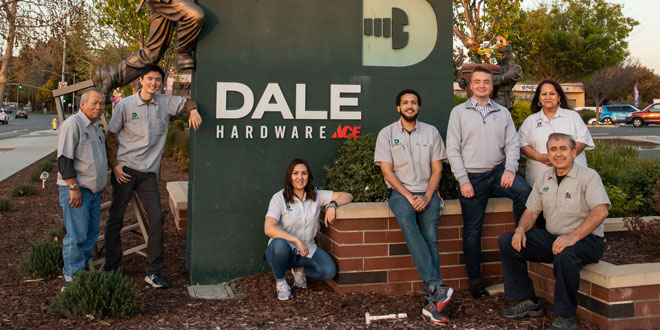Prospective employees at Wankel’s Hardware in New York are asked an unusual interview question: “What is your American dream?”
The question is important because store owner Katherine Wankel’s goal is to provide jobs that she considers to be launch pads for immigrants. Pursuit of social justice and inclusion are part of her company’s mission.
At Dale Hardware in Fremont, California, the question, “What is your preferred language?” is an optional application question most job applicants choose to answer. Candidates don’t have to speak English to get jobs at the store, though speaking multiple languages is a plus for serving the varied customers in Fremont.
Improving diversity in hiring and engaging in practices that actively oppose racism continue to be growing topics of national discourse in the U.S., but providing safe places for people of many ethnicities and cultures to work and shop has been a significant priority for retail businesses like Wankel’s Hardware and Dale Hardware for many years.
Leading an inclusive multicultural team is an integral part of serving a diverse community well. Meeting the needs of a multiethnic community includes employing people who reflect the demographics of the area and listening to diverse employees’ feedback on how they need to be supported and can better serve customers.
Read on to learn how Wankel’s and Dale Hardware have taken intentional steps to serve diverse people.
Responding to Change
When Dale Hardware first opened in 1955, its all-white staff reflected the demographics of the Fremont community.
About 40 years later in the 1990s, the community population began to shift and progressively became more diverse. Now, more than half of local residents are Asian, and the store’s 85 employees represent 20 different countries.
“The Bay Area is a melting pot of so many different nationalities and so many languages,” says Chris Beresford, who serves as the store’s training coordinator. “We’re hiring from a very diverse group of folks.”
The store’s white workers still make up a majority of the team, but about 30 percent of the employees are Hispanic and 22 percent are Asian. English, Spanish, Mandarin and Hindi are employees’ most commonly spoken languages.
Hiring a diverse group of employees came somewhat naturally for Dale Hardware; as the community changed, so did the ethnicities of many of the store’s job applicants. However, the operation went beyond just hiring people from different cultures and took intentional steps to recruit and welcome a variety of employees. They created recruitment commercials for a local Chinese-language TV station, hosted a multicultural barbecue, set up a booth at a Chinese New Year’s festival and published ads in Spanish.
Purposeful Hiring
Wankel’s Hardware has been in business in New York City since 1896, but the store got a new mission in the 1970s that has diversified its employee team and customer base.
The owner, Katherine, wanted to fight social injustice and considered pursuing a career outside of the family business doing service work.
Then she realized she could use the hardware store as a powerful tool for good. She began developing relationships with organizations that help refugees resettle in the U.S., aid people with disabilities gain work experience and help place ex-offenders in jobs after being released from prison.
Fifty years later, Wankel’s Hardware has a long record of providing foundational work experience for people starting new lives—especially immigrants and refugees.
“It’s our responsibility to help new Americans get settled here, establish their roots and make sure they have opportunities just like the rest of us,” vice president Sean Wankel says.
The 2,500-square-foot store has a staff of eight people that has looked very different over the years. A map in the store is marked with the 40 different countries from which employees have emigrated during the past half century.
Employing diverse people allows Wankel’s to serve very specific populations. In fact, staff from the French consulate’s office in New York shop at the store because Wankel’s has employees who speak French.
Building Diverse Teams
Both Dale Hardware and Wankel’s Hardware have built their diverse employee teams by developing hiring practices that make their operations welcoming to a variety of people.
But the traits they look for in job candidates are universal. They want to hire workers who are trustworthy and accepting of people who are different from them, and who have strong work ethics and friendly personalities.
The organizations Wankel’s Hardware works with to recruit immigrants prescreen job candidates for the store, but hiring decisions are made by store staff. Employees’ fit within the business has to do with company culture, not outside cultural factors, Sean Wankel says.
Customers notice the employees’ good attitudes and the store’s positive culture, he says.
“The employees who are refugees are generally very positive because they’re happy they were able to escape war or famine or other hardships,” he says. “That positivity influences the rest of the staff. I’m frequently told we have a very upbeat store environment with smiles all over the place.”
At Dale Hardware, diversity has made the culture more inclusive and the employee turnover lower. It has also increased the whole team’s creativity by allowing the company to incorporate unique ideas. For example, the store has an employee who owned a dollar store prior to moving from Mexico to the U.S. He has thoroughly reorganized and improved the hardware department.
“We’ve realized, as the sense of community grows within our store among people with diverse backgrounds, that everyone feels valued. Employees feel accepted when they see other people like them here,” Beresford says.
Communicating Across Cultures
The greatest challenge of leading a diverse team is communication, according to Wankel. Language can be a barrier, and so can differing understandings of customer service and misinterpreted task instructions.
“When working with new employees from diverse backgrounds, you need to communicate a task and an objective, and then verify they understand the objective by confirming it with them,” Wankel says. “American customer service can be very different from customer service in other cultures, so you need to start from scratch and communicate what you want the customer to experience when they come here and focus on that consistently.”
Missed social cues and misunderstood body language and tones of voice can all contribute to miscommunication within a team.
Providing hands-on product knowledge training, having new hires shadow experienced staff members for the first month on the job, practicing customer service skills in role play activities and providing training refreshers over time all help get the whole team on the same page about job expectations.
Asking employees to overcommunicate and give each other the benefit of the doubt if their feelings get hurt are important, too.
“Communication is an issue in most environments, no matter what,” Wankel says. “Most of the time that’s solved very easily and it’s not a frequent problem. If somebody feels slighted by something, the problem wasn’t necessarily what the other person was trying to communicate. I ask people to take an extra step so there’s full communication. If you feel slighted, go further and ask, ‘Is this what you meant? Because it made me feel this way.’”
Accommodating different languages or types of communication, especially if it requires translation help from a mobile app, takes effort that improves business overall, Beresford says.
Dale Hardware has been able to rely on its diverse staff to grow its customer base. For example, the multicultural team has expanded the store’s ability to serve Chinese customers who only speak Mandarin and reach Spanish speakers through Spanish language advertising.
“We realized having a diverse team is a challenge that is worth having because it’s so rewarding. If you have a group of like-minded people, you’re probably going to generate the same or similar ideas. If you have people with different backgrounds, it helps you be more innovative and creative with things,” Beresford says. “I’m really big into the idea of inclusivity for everybody and giving everyone a fair chance and an opportunity to give jobs their all.”
5 Tips for Creating a Welcoming Culture
1 | Practice fairness.
Create training programs, opportunities for advancement and rewards for good performance that demonstrate that every staff member is equally valued. Find ways for every team member to earn recognition. Celebrate employees equally on their birthdays, for holidays and when they accomplish work goals.
2 | Choose well-suited mentors.
Recruit experienced employees to serve as mentors for new workers. Link mentors based on characteristics that make them a good fit with new hires. At Dale Hardware, a seasoned staff member mentored a new employee who had the same learning disability as the experienced employee’s child. The fit helped the new worker thrive. A shared first language could be another reason for linking a mentor with an employee in training.
3 | Ask for diverse ideas.
One of the key benefits of having a diverse workforce is creating a culture where employees share and appreciate diverse ideas. At Wankel’s Hardware, new and creative ideas for merchandising often come from employees who are new Americans.
4 | Be protective of your team.
Watch for customers and vendors who disrespect your employees. People with disabilities and refugees can be more vulnerable to harassment and may also be less likely to report it to their bosses. Be proactive to create a culture where it’s safe to report any instance of harassment. “It isn’t right for anybody to be disrespected, especially in our workplace,” Sean Wankel at Wankel’s Hardware says. “If you don’t have open communication and trust, there are going to be difficulties.”
5 | Encourage small team projects.
Build teamwork by asking different employees to work together on small projects that require them to communicate about goals and collaborate. The sense of accomplishment team members feel when they complete a project together helps employees bond with each other.
Nurturing Inclusion on Your Team
Diversify your marketing. Find out what local TV, radio, newspaper and other media sources operate in your community in different languages. Learning what’s available may be as simple as asking your employees what TV stations are their favorites in their preferred languages. Dale Hardware’s staff identified where to advertise and then had two employees who speak Mandarin appear in a commercial on the Chinese TV station.
Use technology for quick help. When communicating with co-workers or customers who don’t fluently speak your primary language, use a mobile app to help translate what they’re asking and what you need to say. Dale Hardware employees have used apps such as Google Translate and Apple’s Translate.
Make your store environment inclusive. Adding directional and product department signage in all of the languages spoken locally makes your store more shoppable and welcoming for customers who don’t speak English as their first language.
 Hardware Retailing The Industry's Source for Insights and Information
Hardware Retailing The Industry's Source for Insights and Information






